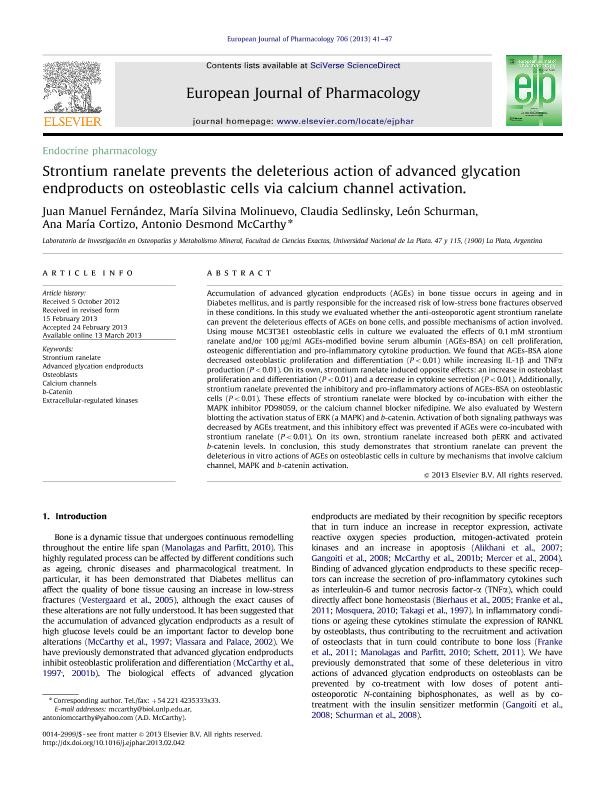Artículo
Strontium ranelate prevents the deleterious action of advanced glycation endproducts on osteoblastic cells via calcium channel activation
Fernández, Juan Manuel ; Molinuevo, Maria Silvina
; Molinuevo, Maria Silvina ; Sedlinsky, Claudia; Schurman, León; Cortizo, Ana María; McCarthy, Antonio Desmond
; Sedlinsky, Claudia; Schurman, León; Cortizo, Ana María; McCarthy, Antonio Desmond
 ; Molinuevo, Maria Silvina
; Molinuevo, Maria Silvina ; Sedlinsky, Claudia; Schurman, León; Cortizo, Ana María; McCarthy, Antonio Desmond
; Sedlinsky, Claudia; Schurman, León; Cortizo, Ana María; McCarthy, Antonio Desmond
Fecha de publicación:
03/2013
Editorial:
Elsevier
Revista:
European Journal of Pharmacology
ISSN:
0014-2999
Idioma:
Inglés
Tipo de recurso:
Artículo publicado
Clasificación temática:
Resumen
Accumulation of advanced glycation endproducts (AGEs) in bone tissue occurs in ageing and in Diabetes mellitus, and is partly responsible for the increased risk of low-stress bone fractures observed in these conditions. In this study we evaluated whether the anti-osteoporotic agent strontium ranelate can prevent the deleterious effects of AGEs on bone cells, and possible mechanisms of action involved. Using mouse MC3T3E1 osteoblastic cells in culture we evaluated the effects of 0.1mM strontium ranelate and/or 100µg/ml AGEs-modified bovine serum albumin (AGEs-BSA) on cell proliferation, osteogenic differentiation and pro-inflammatory cytokine production. We found that AGEs-BSA alone decreased osteoblastic proliferation and differentiation (P<0.01) while increasing IL-1<beta> and TNF<alpha> production (P<0.01). On its own, strontium ranelate induced opposite effects: an increase in osteoblast proliferation and differentiation (P<0.01) and a decrease in cytokine secretion (P<0.01). Additionally, strontium ranelate prevented the inhibitory and pro-inflammatory actions of AGEs-BSA on osteoblastic cells (P<0.01). These effects of strontium ranelate were blocked by co-incubation with either the MAPK inhibitor PD98059, or the calcium channel blocker nifedipine. We also evaluated by Western blotting the activation status of ERK (a MAPK) and b-catenin. Activation of both signaling pathways was decreased by AGEs treatment, and this inhibitory effect was prevented if AGEs were co-incubated with strontium ranelate (P<0.01). On its own, strontium ranelate increased both pERK and activated b-catenin levels. In conclusion, this study demonstrates that strontium ranelate can prevent the deleterious in vitro actions of AGEs on osteoblastic cells in culture by mechanisms that involve calcium channel, MAPK and b-catenin activation.
Archivos asociados
Licencia
Identificadores
Colecciones
Articulos(CCT - LA PLATA)
Articulos de CTRO.CIENTIFICO TECNOL.CONICET - LA PLATA
Articulos de CTRO.CIENTIFICO TECNOL.CONICET - LA PLATA
Citación
Fernández, Juan Manuel; Molinuevo, Maria Silvina; Sedlinsky, Claudia; Schurman, León; Cortizo, Ana María; et al.; Strontium ranelate prevents the deleterious action of advanced glycation endproducts on osteoblastic cells via calcium channel activation; Elsevier; European Journal of Pharmacology; 706; 1-3; 3-2013; 41-47
Compartir
Altmétricas



